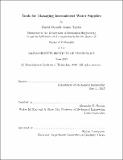| dc.contributor.advisor | Alexander H. Slocum. | en_US |
| dc.contributor.author | Taylor, David Donald James | en_US |
| dc.contributor.other | Massachusetts Institute of Technology. Department of Mechanical Engineering. | en_US |
| dc.date.accessioned | 2018-10-22T18:27:27Z | |
| dc.date.available | 2018-10-22T18:27:27Z | |
| dc.date.copyright | 2018 | en_US |
| dc.date.issued | 2018 | en_US |
| dc.identifier.uri | http://hdl.handle.net/1721.1/118666 | |
| dc.description | Thesis: Ph. D., Massachusetts Institute of Technology, Department of Mechanical Engineering, 2018. | en_US |
| dc.description | This electronic version was submitted by the student author. The certified thesis is available in the Institute Archives and Special Collections. | en_US |
| dc.description | Cataloged from student-submitted PDF version of thesis. | en_US |
| dc.description | Includes bibliographical references (pages 239-253). | en_US |
| dc.description.abstract | Nearly one billion people receive water from piped networks that are not always pressurized. These intermittent water supplies (IWS) are more likely to recontaminate the distributed water than continuously-operated (or '24x7') water supplies. In addition, IWS may not provide customers with enough water. Improving the safety and sufficiency of IWS requires new management tools. This thesis proposes some such tools. Specifically, this thesis develops a suite of hydraulic, financial, and water quality models that show how each is affected by a utility's operational decisions. The proposed models are simple and do not require information about a pipe network's topology. To contextualize this work, an overview of Delhi, India's IWS is provided. The hydraulic model relates the supply pressure, supply duration, leakage rate, and volume of water received by customers. It shows that an IWS' behavior changes substantially when its customers receive the water they demand (i.e., are satisfied) and suggests why IWS exist and persist. The financial model additionally considers a utility's variable revenues and costs. It finds that low-pressure and intermittent operations maximize a utility's (short-term) gross margin and that current performance indicators encourage inequity. Where utilities are financially-motivated (e.g., performance-based contracts) the need for careful regulation and better benchmarks is demonstrated. Optimal performance penalties are proposed to ensure leak repair and high-pressure continuous water supply. The water quality model considers the conditions in which external contaminants can enter a pipe network. It shows that IWS have opposite effects on water quality during steady-state and non-steady-state operations. Both states should be regulated, modeled, and sampled. These models show that knowing the point at which customers become satisfied is crucial to managing and optimizing IWS. To better measure this point, a more accurate multi-jet water meter, which does not measure air, is designed and tested for use in IWS. The tools presented in this thesis support measuring and making progress towards global efforts such as the Sustainable Development Goals and the human right to water, promoting "safe" water supplies that are "available when needed." | en_US |
| dc.description.statementofresponsibility | by David Donald James Taylor. | en_US |
| dc.format.extent | 253 pages | en_US |
| dc.language.iso | eng | en_US |
| dc.publisher | Massachusetts Institute of Technology | en_US |
| dc.rights | MIT theses are protected by copyright. They may be viewed, downloaded, or printed from this source but further reproduction or distribution in any format is prohibited without written permission. | en_US |
| dc.rights.uri | http://dspace.mit.edu/handle/1721.1/7582 | en_US |
| dc.subject | Mechanical Engineering. | en_US |
| dc.title | Tools for managing intermittent water supplies | en_US |
| dc.type | Thesis | en_US |
| dc.description.degree | Ph. D. | en_US |
| dc.contributor.department | Massachusetts Institute of Technology. Department of Mechanical Engineering | |
| dc.identifier.oclc | 1057268826 | en_US |
